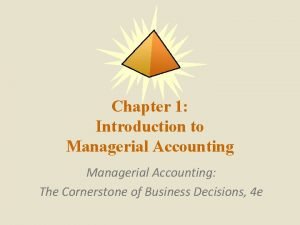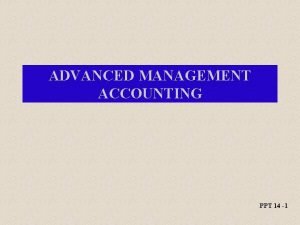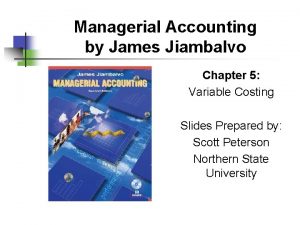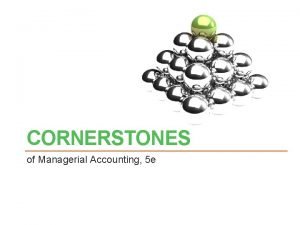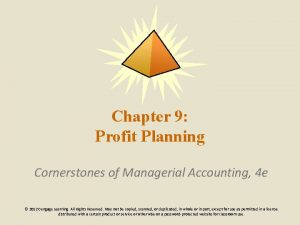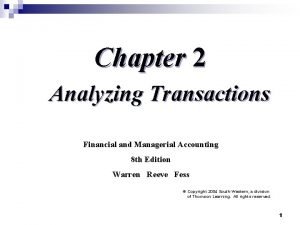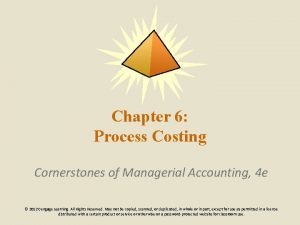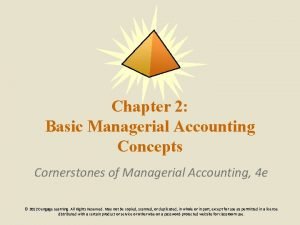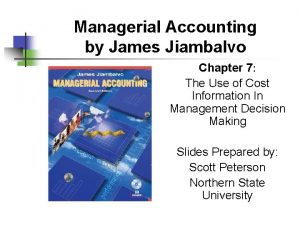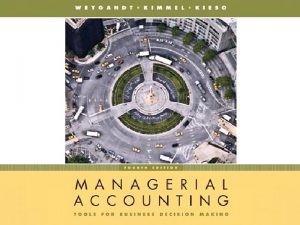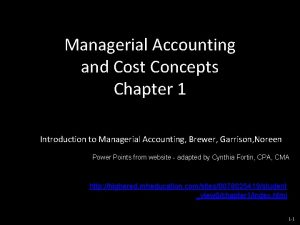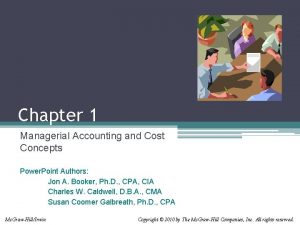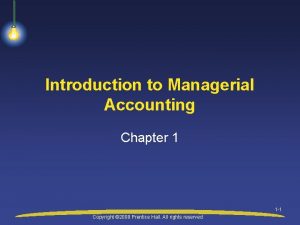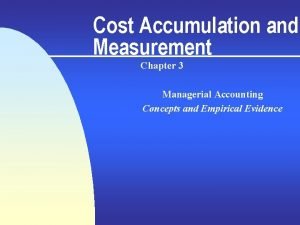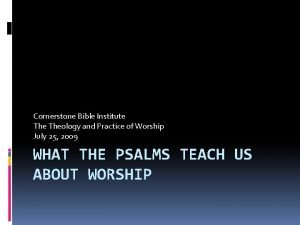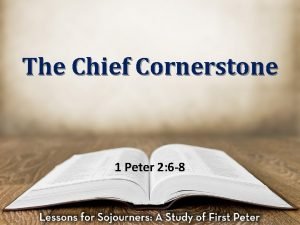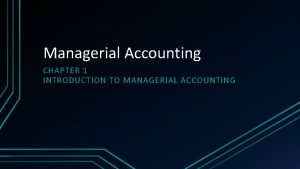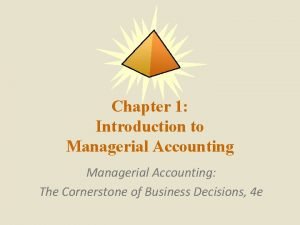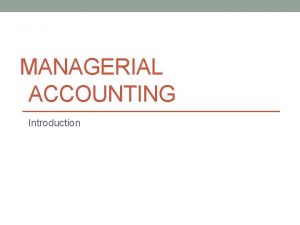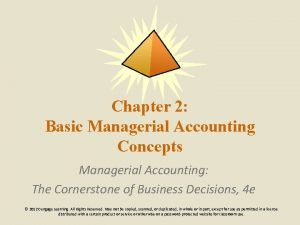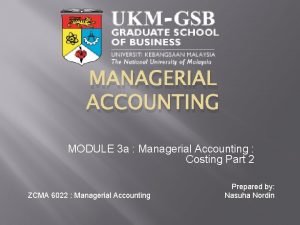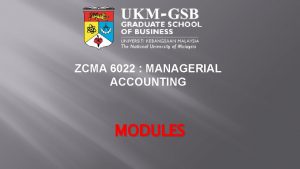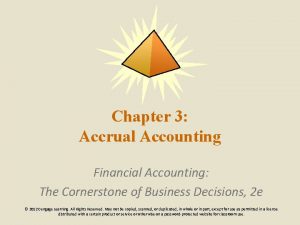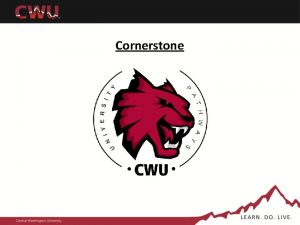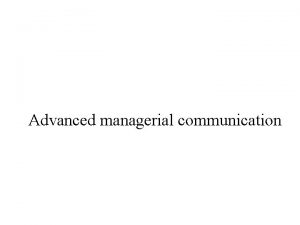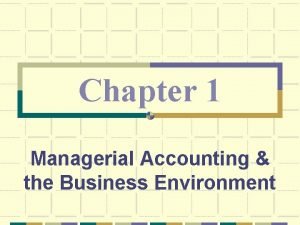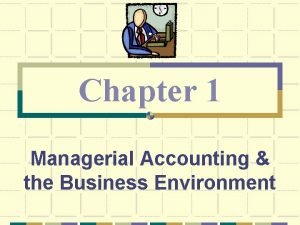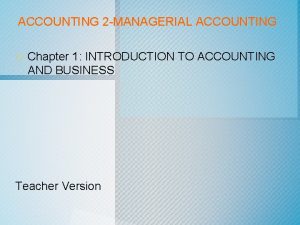Chapter 1 Introduction to Managerial Accounting The Cornerstone





















- Slides: 21

Chapter 1: Introduction to Managerial Accounting: The Cornerstone of Business Decisions, 4 e

Learning Objectives 1. Explain the meaning of managerial accounting. 2. Explain the differences between managerial accounting and financial accounting. 3. Identify and explain the current focus of managerial accounting. 4. Describe the role of managerial accountants in an organization.

1 The Meaning of Managerial Accounting ► Managerial Accounting is the provision of accounting information for a company’s internal users. ► Unlike financial accounting, managerial accounting is not bound by any formal criteria such as generally accepted accounting principles (GAAP). ► Managerial accounting has three broad objectives: 1 2 3 • To provide information for planning the organization’s actions. • To provide information for controlling the organization’s actions. • To provide information for making effective decisions.

1 Planning The detailed formulation of action to achieve a particular end is the management activity called planning. Example Setting objectives Improve Quality Identifying methods to achieve those objectives Supplier Evaluation Program

1 Controlling The managerial activity of monitoring a plan’s implementation and taking corrective action as needed is referred to as controlling. Compare Actual Performance Expected Performance

1 Decision Making The process of choosing among competing alternatives is called decision making. Competing Alternative #1 ? ? ? ? ? Competing Alternative #2

2 Financial Accounting and Managerial Accounting ► Financial Accounting is primarily concerned with producing information for external users, including investors, creditors, customers, suppliers, government agencies, and labor unions. ► Financial accounting’s orientation is historical and is used for investment decisions, stewardship evaluation, monitoring activity, and regulatory measures. ► Financial statements must conform to certain rules and conventions defined by agencies like the Securities and Exchange Commission (SEC), the Financial Accounting Standards Board (FASB), and the International Accounting Standards Board (IASB).

2 Financial Accounting and Managerial Accounting (continued) ► Managerial Accounting produces information for internal users, such as managers, executives, and workers. ► Thus, managerial accounting could be properly called internal accounting, and financial accounting could be called external accounting. ► Specifically, managerial accounting identifies, collects, measures, classifies, and reports financial and nonfinancial information that is useful to internal users in planning, controlling, and decision making.

Comparison of Financial and Managerial Financial Accounting Managerial Accounting 2 • External parties ( & internal) • Internal parties • Must follow externally imposed rules (GAAP) • No mandatory rules • Preparation is mandatory, required by law • Preparation is not mandatory • Objective financial information • Financial and information; subjective information possible nonfinancial • Historical orientation • Future orientation • Information about the firm as • Segmentation reporting a whole • More self-contained • Infrequent interval (eg: Once a year) • Broad, multidisciplinary • Frequent interval

2 Comparison of Financial and Managerial Accounting (continued) The key point is flexibility— the accounting system should be able to supply different information for different purposes.

3 Current Focus of Managerial Accounting ► The business environment in which companies operate has changed dramatically over the past several decades. ►As a result, effective managerial accounting systems also have changed in order to provide information that helps improve companies’ planning, control, and decisionmaking activities. ► Several important uses of managerial accounting resulting from these advances include: (1) new methods of estimating product and service cost and profitability, (2) understanding customer orientation, (3) evaluating the business from a cross -functional perspective, and (4) providing information useful in improving total quality.

3 New Methods of Costing Products and Services ► Today’s companies need focused, accurate information on the cost of the products and services they produce. ►Activity-based costing (ABC) is a more detailed approach to determining the cost of goods and services. ►ABC improves costing accuracy by emphasizing the cost of the many activities or tasks that must be done to produce a product or offer a service. ►Process-value analysis focuses on the way in which companies create value for customers. ►The objective is to find ways to perform necessary activities more efficiently and to eliminate those that do not create customer value.

3 Customer Orientation ► Customer value is a key focus because firms can establish a competitive advantage by creating better customer value for the same or lower cost than competitors or creating equivalent value for lower cost than that of competitors. ► Customer value is the difference between what a customer receives and what the customer gives up when buying a product or service.

3 Strategic Positioning ► Effective cost information can help the company identify strategies that increase customer value. This is typically done through a couple of general strategies: ►Cost Leadership: The objective of the cost leadership strategy is to provide the same or better value to customers at a lower cost than competitors. ►Superior products through differentiation: A differentiation strategy strives to increase customer value by providing something to customers not provided by competitors.

3 Value Chain ► Successful pursuit of cost leadership and/or differentiation strategies requires an understanding of a firm’s value chain. ► The value chain is the set of activities required to design, develop, produce, market, and deliver products and services, as well as provide support services to customers.

3 Cross-Functional Perspective ►In managing the value chain, a managerial accountant must understand measure many functions of the business. ►Contemporary approaches to costing may include initial design and engineering costs, as well as manufacturing costs, and the costs of distribution, sales, and service.

3 Total Quality Management ►Continuous improvement is the continual search for ways to increase the overall efficiency and productivity of activities by reducing waste, increasing quality, and managing costs. ►Continuous improvement is fundamental for establishing excellence. ►A philosophy of total quality management, in which manufacturers strive to create an environment that will enable workers to manufacture perfect (zero-defect) products, has created a demand for a managerial accounting system that provides information about quality.

3 Total Quality Management (continued) ► For example, many companies attempt to increase organizational value by eliminating wasteful activities that exist throughout the value chain. ► This has led to a change in accounting, referred to as lean accounting, which organizes costs according to the value chain and collects both financial and nonfinancial information. ► A more recent charge of managerial accountants is to help carry out the company’s enterprise risk management (ERM) approach. ► ERM is a formal way for managerial accountants to identify and respond to the most important threats and business opportunities facing the organization.

3 Time As A Competitive Element ►Time is a crucial element in all phases of the value chain. World-class firms reduce time to market by compressing design, implementation, and production cycles. ►These firms deliver products or services quickly by eliminating nonvalue-added time, which is time of no value to the customer (e. g. , the time a product spends on the loading dock). ►Interestingly, decreasing nonvalue-added time appears to go hand in hand with increasing quality.

3 Efficiency ►Improving efficiency is also a vital concern. ►Both financial and nonfinancial measures of efficiency are needed. ►Cost is a critical measure of efficiency. ►For these efficiency measures to be of value, costs must be properly defined, measured, and assigned; furthermore, production of output must be related to the inputs required, and the overall financial effect of productivity changes should be calculated.

4 The Role of the Managerial Accountant ► The role of managerial accountants in an organization is one of support. ► They assist those individuals who are responsible for carrying out an organization’s basic objectives. ► Positions that have direct responsibility for the basic objectives of an organization are referred to as line positions. ► Positions that are supportive in nature and have only indirect responsibility for an organization’s basic objectives are called staff positions. ► The controller supervises all accounting functions and reports directly to the general manager and chief operating officer. ► In larger companies, the controller is separate from the treasury department. The treasurer is responsible for the finance function.
 Management accounting chapter 1
Management accounting chapter 1 Introduction to managerial accounting ppt
Introduction to managerial accounting ppt Managerial accounting chapter 5 solutions
Managerial accounting chapter 5 solutions Managerial accounting chapter 13 solutions
Managerial accounting chapter 13 solutions Planning in managerial accounting
Planning in managerial accounting Chapter 2 solutions managerial accounting
Chapter 2 solutions managerial accounting Process costing problems and solutions doc
Process costing problems and solutions doc Managerial accounting chapter 2
Managerial accounting chapter 2 Managerial accounting chapter 7
Managerial accounting chapter 7 Chapter 1 managerial accounting
Chapter 1 managerial accounting Relevant range managerial accounting
Relevant range managerial accounting Methods of cost estimation in managerial economics
Methods of cost estimation in managerial economics Chapter 1 managerial accounting and cost concepts
Chapter 1 managerial accounting and cost concepts Managerial accounting chapter 1
Managerial accounting chapter 1 Managerial accounting chapter 3
Managerial accounting chapter 3 Cornerstone bible institute
Cornerstone bible institute The chief cornerstone high school
The chief cornerstone high school Is a cornerstone in the protection of information assets
Is a cornerstone in the protection of information assets Cornerstone my hope is built
Cornerstone my hope is built Define chief cornerstone
Define chief cornerstone Cornerstone big data
Cornerstone big data Cornerstone employer
Cornerstone employer
